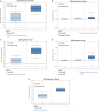Squalene epoxidase promotes the proliferation and metastasis of lung squamous cell carcinoma cells though extracellular signal-regulated kinase signaling
- PMID: 30734525
- PMCID: PMC6397918
- DOI: 10.1111/1759-7714.12944
Squalene epoxidase promotes the proliferation and metastasis of lung squamous cell carcinoma cells though extracellular signal-regulated kinase signaling
Abstract
Background: The biological function of squalene epoxidase (SQLE), an important rate-limiting enzyme in downstream cholesterol synthesis, is to convert squalene to 2-3 oxacin squalene. The expression of SQLE in lung cancer is abnormal. We conducted this study to investigate the effect of SQLE expression on lung squamous cell carcinoma (SCC) proliferation, migration, and invasion and its role in extracellular signal-regulated kinase (ERK) signaling.
Methods: Cell Counting Kit 8, wound healing, and Transwell assays; Western blotting; and quantitative real-time PCR were used to investigate the effect of SQLE in a lung SCC H520 cell line. Kaplan-Meier analysis was used to identify the prognostic significance of SQLE.
Results: Overexpression of SQLE promoted lung SCC cell proliferation, migration and invasion, whereas knockdown of SQLE expression showed the opposite effect. SQLE can interact with ERK to enhance its phosphorylation. SQLE may contribute to the pathogenesis of lung cancer by modulating ERK signaling. Further survival analysis indicated that high expression of SQLE indicated poor prognosis in lung SCC.
Conclusion: Our study presents novel evidence of potential biomarkers or therapeutic targets for lung SCC therapy and prognosis.
Keywords: ERK signal; SQLE; invasion; migration; proliferation.
© 2019 The Authors. Thoracic Cancer published by China Lung Oncology Group and John Wiley & Sons Australia, Ltd.
Figures


 Negative control (NC);
Negative control (NC);  CON083;
CON083;  SQLE. (e) Cell migration was detected by wound healing assay. (f) Cell invasion was detected by transwell assay. Each assay was repeated at least three times. Data from one representative experiment is presented as mean ± standard deviation. **, P < 0.01. GAPDH, glyceraldehyde 3‐phosphate dehydrogenase; mRNA, messenger RNA; OD, optical density.
SQLE. (e) Cell migration was detected by wound healing assay. (f) Cell invasion was detected by transwell assay. Each assay was repeated at least three times. Data from one representative experiment is presented as mean ± standard deviation. **, P < 0.01. GAPDH, glyceraldehyde 3‐phosphate dehydrogenase; mRNA, messenger RNA; OD, optical density.
 ;
;  SQLE‐1853;
SQLE‐1853;  SQLE‐1640. (e) Cell migration was detected by wound healing assay. (f) Cell invasion was detected by transwell assay. Each assay was repeated at least three times. Data from one representative experiment is presented as mean ± standard deviation. **, P < 0.01 ***, P < 0.001. GAPDH, glyceraldehyde 3‐phosphate dehydrogenase; mRNA, messenger RNA; OD, optical density.
SQLE‐1640. (e) Cell migration was detected by wound healing assay. (f) Cell invasion was detected by transwell assay. Each assay was repeated at least three times. Data from one representative experiment is presented as mean ± standard deviation. **, P < 0.01 ***, P < 0.001. GAPDH, glyceraldehyde 3‐phosphate dehydrogenase; mRNA, messenger RNA; OD, optical density.

 low;
low;  high. HR, hazard ratio.
high. HR, hazard ratio.References
Publication types
MeSH terms
Substances
LinkOut - more resources
Full Text Sources
Medical
Research Materials
Miscellaneous

